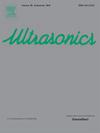Enhancing thrombolysis efficiency using acoustic vortex tweezers and microbubbles: a microscale mechanistic study with experimental validation
IF 3.8
2区 物理与天体物理
Q1 ACOUSTICS
引用次数: 0
Abstract
Previous research has shown that acoustic vortex tweezers (AVT) combined with microbubbles (MBs) and tissue plasminogen activator (t-PA) can enhance thrombolytic efficiency. However, due to varying evaluation methods, an objective framework for investigating its mechanisms is lacking. This study establishes a standardized thrombolysis evaluation protocol to compare AVT, t-PA, and MBs with mainstream sonothrombolysis and to explore their thrombolytic mechanisms. A miniature ultrasound transducer capable of generating an AVT field was applied to fluorescent fibrin clots. The MB penetration and fibrin structure changes were observed using a high-speed camera and confocal microscopy. The drug permeability, thrombolytic efficiency, fragment size, and quantity were then quantified to assess the efficacy and safety of AVT. The results showed that AVT with MBs produced deeper (up to 30 μm) and wider MBs channels and increased fibrin looseness by 32.6 %, significantly enhancing t-PA penetration and fibrin clot dissolution. Within 30 min, the dissolution area in the AVT + t-PA + MBs group was 43.6 % larger than the t-PA only group, without creating excessive or oversized fragments. These findings confirm the potential of AVT for promoting fibrin disruption and drug penetration. Future validation using ex vivo vascular models and animal studies may position AVT as an important adjunct therapy in clinical thrombolysis.
利用声涡旋镊子和微泡提高溶栓效率:一项具有实验验证的微观机制研究
先前的研究表明,声学涡旋镊子(AVT)与微泡(mb)和组织型纤溶酶原激活剂(t-PA)结合可以提高溶栓效率。然而,由于评价方法不一,缺乏一个客观的框架来研究其机制。本研究建立了标准化的溶栓评价方案,将AVT、t-PA和mb与主流的超声溶栓进行比较,探讨其溶栓机制。一种能够产生AVT场的微型超声换能器应用于荧光纤维蛋白凝块。用高速相机和共聚焦显微镜观察MB的穿透和纤维蛋白结构的变化。定量观察药物通透性、溶栓效率、碎片大小和数量,评价AVT的疗效和安全性。结果表明,带mb的AVT产生更深(达30 μm)和更宽的mb通道,使纤维蛋白疏松度增加32.6%,显著增强t-PA渗透和纤维蛋白凝块溶解。在30分钟内,AVT + t-PA + mb组的溶解面积比t-PA组大43.6%,没有产生过多或过大的碎片。这些发现证实了AVT促进纤维蛋白破坏和药物渗透的潜力。未来通过离体血管模型和动物研究的验证可能会使AVT成为临床溶栓的重要辅助治疗。
本文章由计算机程序翻译,如有差异,请以英文原文为准。
求助全文
约1分钟内获得全文
求助全文
来源期刊

Ultrasonics
医学-核医学
CiteScore
7.60
自引率
19.00%
发文量
186
审稿时长
3.9 months
期刊介绍:
Ultrasonics is the only internationally established journal which covers the entire field of ultrasound research and technology and all its many applications. Ultrasonics contains a variety of sections to keep readers fully informed and up-to-date on the whole spectrum of research and development throughout the world. Ultrasonics publishes papers of exceptional quality and of relevance to both academia and industry. Manuscripts in which ultrasonics is a central issue and not simply an incidental tool or minor issue, are welcomed.
As well as top quality original research papers and review articles by world renowned experts, Ultrasonics also regularly features short communications, a calendar of forthcoming events and special issues dedicated to topical subjects.
 求助内容:
求助内容: 应助结果提醒方式:
应助结果提醒方式:


